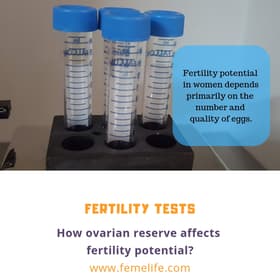What are the tests done for infertility?

When a woman is undergoing a fertility work-up, Cycle Day 3 is the day she has blood work performed to check the levels of three important levels: follicle stimulating hormone (FSH), luteinizing hormone (LH) and estradiol (E2).
The FSH blood test is used to help diagnose problems with sexual development, menstruation, and fertility. It can be used to diagnose or evaluate polycystic ovary disease, ovarian cysts, irregular vaginal bleeding and infertility.
The LH blood test measures the amount of luteinizing hormone, which is also secreted by the pituitary gland. In women, LH levels rise at mid-cycle; within 24 to 36 hours, ovulation occurs. Higher-than-normal levels of LH indicate several disorders, including ovarian failure and polycystic ovary disease.
Estradiol is the most important form of estrogen. It is primarily made in and released from the ovaries, adrenal cortex and the placenta, and it is responsible for the growth of the breasts, outer genitals, uterus, fallopian tubes and vagina.
The natural levels of prolactin in the body change throughout the day. Levels gradually rise overnight and are at their highest in the morning. High levels of prolactin in the blood can stop the ovaries from making the hormone estrogen and may cause infertility. Thyroid hormones are important in preventing miscarriage and aiding foetal brain development. Low levels of thyroid hormone can interfere with the release of an egg from your ovary (ovulation), which impairs fertility.
Anti-Müllerian hormone (AMH), a marker of ovarian reserve, declines over a woman's reproductive lifespan. AMH is highly correlated with a woman's age and number of primordial ovarian follicles. In women, anti-Müllerian hormone (AMH) is exclusively produced by granulosa cells of ovarian follicles during the early stages of follicle development. AMH concentrations slowly decrease with increasing age until becoming undetectable ∼5 years before menopause.
AMH serum concentration does accurately reflect the size of the pool of antral follicles, representing the quantity of the remaining primordial follicles.
Read more
https://femelife.com/ivf-fertility-care/infertility-when-see-a-doctor/